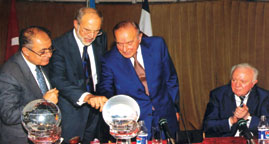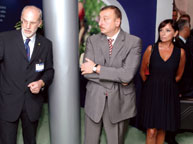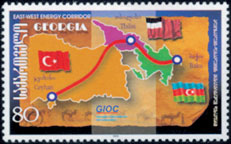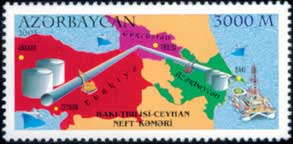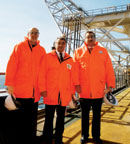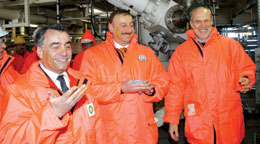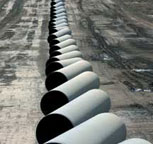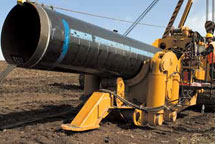|

Autumn 2006 (14.3)
Pages
82-90
Pipeline Completed
David
Woodward Reflects on Accomplishments in Azerbaijan
by David
Woodward
1. History
of Azeri-Chirag-Gunashli (1994-2006)
2. History
of Baku-Tbilisi-Ceyhan (BTC) Pipeline Project
Finally, Azerbaijan's oil is flowing
to international markets via the Baku - Tbilisi - Ceyhan Pipeline.
Azerbaijan International's editor Betty Blair sat down with David
Woodward, President of BP Azerbaijan and AIOC to reflect on the
enormous project just accomplished. Woodward has been leading
BP's activities in Azerbaijan since 1998. See Blair's interview:
"At the Turn of the 21st Century": AI 7.4 (Winter 1999).
Search at AZER.com
AI: We're delighted to have
the chance to sit down with you again, now nearly seven years
after our initial interview with you in 1999. Well, the pipeline
was finally commissioned this past July 2006 and tankers have
left the Turkish port of Ceyhan and are heading to international
markets. This is the occasion that Azerbaijanis have been dreaming
of for more than a decade. You've played a tremendous role in
all of this, having headed the operations for BP for the past
eight years. Help us understand the scope of this project and
your involvement in it. What's happened since you arrived on
the scene in 1998?
  Woodward:
Well, when talking about the project here in Azerbaijan,
people tend to focus on the pipeline [Baku -Tbilisi - Ceyhan,
usually simply referred to as BTC]. Woodward:
Well, when talking about the project here in Azerbaijan,
people tend to focus on the pipeline [Baku -Tbilisi - Ceyhan,
usually simply referred to as BTC].
But the oil and gas developments that we've been involved in
encompass much more than that, although without a doubt, the
BTC pipeline is a very significant development in its own right.
For example, in the Azeri - Chirag - Gunashli (ACG) field in
the Azerbaijan sector of the Caspian, we have undertaken the
major development of the some 16 billion barrels of oil in the
ground.
AI: I don't have a clue how
to even begin comprehending how much oil that is? How does one
imagine what 16 billion barrels of oil looks like?
Woodward: A very large tanker would carry a million
barrels of oil, so we're talking about 16,000 of those giant
tankers full of oil. Without a doubt, it's a huge amount.
AI: How long does it take to fill a tanker with a million
barrels of oil?
Woodward: Normally, it takes a day, but that's
because we fill storage tanks with oil, so it's just a matter
of flowing the oil from the storage tanks into the tanker. There
aren't many fields around the world that can produce a million
barrels of oil a day and fill a large tanker every day.
AI: Those tankers? They're
bigger than a football field, aren't they?
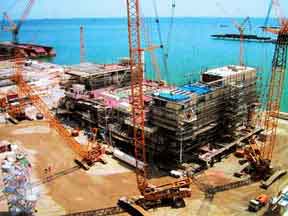  Woodward:
Yes, they're several hundred meters long. They can hold a
huge amount of oil. Eventually, oil from the ACG field will be
filling up one of those tankers each day when our production
reaches its maximum capacity at the end of 2008 / 2009. Woodward:
Yes, they're several hundred meters long. They can hold a
huge amount of oil. Eventually, oil from the ACG field will be
filling up one of those tankers each day when our production
reaches its maximum capacity at the end of 2008 / 2009.
In terms of what we've been doing for the last decade, if we
go back to the 1990s, BP and its partners undertook what was
called the Early Oil Project with the development of Chirag.
It was, in effect, a pilot project.
Above:
Living quarters being installed
on the Central Azeri integrated deck, October 2004
It proved that we could develop
ACG in accordance with international standards - technically,
commercially and environmentally. That project came on - stream
in 1997, and we produced it through a relatively small terminal.
We built Sangachal and began utilizing the Northern Export Route
[via Russia to Novorossiysk on the Black Sea], an existing pipeline
that had been refurbished.
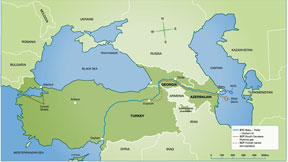  Then
in 1999, we commissioned the Western route, which was both partially
new and partially refurbished.It enabled us to export oil via
Supsa on the Georgian Black Sea coast.By 2000-2001, we had sufficient
confidence that we could operate here in Azerbaijan in accordance
with the standards that we follow elsewhere around the world
and that encouraged us and our partners in AIOC to move ahead
with what we call Full Field Development of ACG, which involves
three major phases of development. Then
in 1999, we commissioned the Western route, which was both partially
new and partially refurbished.It enabled us to export oil via
Supsa on the Georgian Black Sea coast.By 2000-2001, we had sufficient
confidence that we could operate here in Azerbaijan in accordance
with the standards that we follow elsewhere around the world
and that encouraged us and our partners in AIOC to move ahead
with what we call Full Field Development of ACG, which involves
three major phases of development.
Above:
Map showing the route of
the Baku-Tbilisi-Ceyhan (BTC) Pipeline as well as the parallel
route for the South Caucasus Pipeline from landlocked Azerbaijan.
The blue line is for oil; the red, for gas. The BTC pipeline
crosses three countries (Azerbaijan, Georgia and Turkey) on its
1768 km journey from the Caspian to the Mediterranean where the
oil is pumped into tankers and sent to world markets. BTC is
the second longest pipeline in the world.
Construction began in September 2002. First Oil began its long
journey through the pipeline on May 10, reaching its destination
at Ceyhan on May 28, 2006. The first tanker sailed away to world
markets on June 4, 2006. Baku expects to be pumping at least
1 million barrels per day of its own oil when its fields are
fully operational
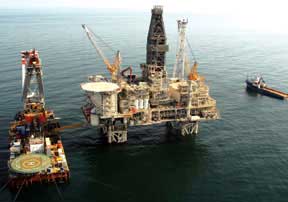  Left: East Azeri topsides installed offshore, 2006 Left: East Azeri topsides installed offshore, 2006
We first focused on
Central Azeri and then moved on to East and West Azeri. Now we're
developing Deep - Water Gunashli. So far we have installed jackets
and topsides for the three Central, West and East Azeri production,
drilling and accommodation platforms. We have also installed
a very major facility we call the Compression and Water Injection
Platform (CWIP), which injects some of the gas that is associated
with the oil back into the reservoir to maximize oil production.
The CWIP will also inject seawater around the periphery of the
field to help displace the oil into the producing well. In 2008,
we'll start up Deep-Water Gunashli with two more platforms and
so altogether Full Field Development will comprise six major
platforms. There will also be a thousand kilometers of flow lines
laid on the seabed to transport the oil and gas from these platforms
to the Sangachal Terminal.
AI: Pipelines on the bottom
of the sea?
Woodward: Yes, we have
a special pipe lay barge that can lay sections of pipe that are
welded together down on the seabed in order to take the oil and
gas from the platforms and transport it ashore.
Above: Left: Ceremony at the Sangachal Terminal
to launch the construction of the BTC pipeline. The presidents
of the three countries through which the pipeline crosses participated
in the inauguration: Left:
Turkish President Ahmet Necdet Sezer, BP's Woodward, Azerbaijan
President Heydar Aliyev and Georgian President Eduard Shevardnadze,
September 18, 2002.
Right: BP's David Woodward at the Caspian
Oil and Gas Exhibition in Baku with Azerbaijan's President Ilham
Aliyev and his wife Mehriban (June 2006)
AI: What size are they?
Woodward: The pipes
lying on the Caspian seabed are up to 30 inches in diameter.
Rather sizeable. The BTC pipeline through Azerbaijan and Georgia
to Turkey, is mostly 42 inches in diameter. It some places, it's
46 inches. Occasionally it narrows down to 36 inches, largely
depending on whether the pipeline is going uphill or downhill.
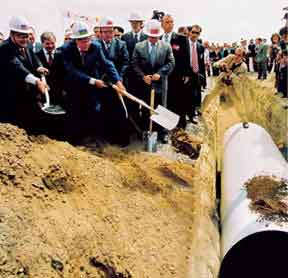  Left: Launching the construction of the BTC Pipeline.
Left: U.S. Secretary of Energy Spencer Abraham, Azerbaijan President
Heydar Aliyev, Georgian President Eduard Shevardnadze and Turkish
President Ahmet Necdet Sezer. Sangachal Terminal near Baku on
September 18, 2002 Left: Launching the construction of the BTC Pipeline.
Left: U.S. Secretary of Energy Spencer Abraham, Azerbaijan President
Heydar Aliyev, Georgian President Eduard Shevardnadze and Turkish
President Ahmet Necdet Sezer. Sangachal Terminal near Baku on
September 18, 2002
So we've undertaken
this huge oil development offshore. As a part of this, we have
pre-drilled a number of wells before we put the jackets there.
The wells are drilled from a subsea template on the seabed and
then the platform is placed on the top of the pre-drilled wells,
which can be tied back to the platform. This has enabled us to
bring production on more rapidly, rather than starting to drill
the wells only once the platform is in place.
At Sangachal, we've had to build a whole new terminal expanding
the Early Oil Project terminal. Again, we did it in three phases.
We've commissioned two phases already. And the third phase will
come on in time for the Deep-Water Gunashli development. Seen
from the air, Sangachal Terminal is one of the largest terminals
in the world, covering an area of 540 hectares.
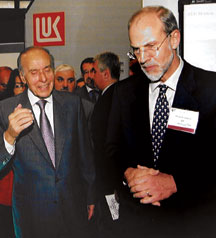  Left: David Woodward with President Heydar Aliyev at
the Ninth Annual Caspian Oil and Gas Exhibition and Conference
in Baku (June 2002) This was the last oil exhibition that President
Aliyev attended. He had been the driving force in establishing
this international exhibition and the impetus for its enormous
success Left: David Woodward with President Heydar Aliyev at
the Ninth Annual Caspian Oil and Gas Exhibition and Conference
in Baku (June 2002) This was the last oil exhibition that President
Aliyev attended. He had been the driving force in establishing
this international exhibition and the impetus for its enormous
success
That makes it more than
a couple of kilometers long. Crude oil storage tanks are just
one component of the terminal. We have three new tanks, which
gives us a total storage capacity of about three million barrels
of oil. And then there's the pipeline which starts at the Sangachal
Terminal.
While it is the construction of the pipeline that has received
most of the public attention, more than three quarters of the
project-three quarters of the total investment-centers on activities
upstream. Actually, the pipeline only comprises about 20 percent
or less of the project.
So on the pipeline, there were many issues to resolve. First,
a route had to be selected, then agreements with the transit
countries were negotiated, and engineering and environmental
studies were undertaken. Then financing had to be arranged and
investors secured - that is, we had to find oil companies who
were prepared to put their money into the project and transport
their oil through the pipeline. Only then could the construction
phase commence. That involved purchasing access to thousands
of land plots and transporting 160,000 joints of pipe to location.
At our peak construction, 22,000 workers were working on the
pipeline project. But we managed to arrange it in such a way
that not a single family had to be relocated from their homes.
The pipeline is buried along its entire length and the ground
re-instated to its original condition such that owners can continue
to use it for growing crops and grazing their herds.
BTC is a huge engineering endeavor
in its own right. It's 1,768 kilometers long (nearly 1,100 miles);
it crosses 1,500 rivers and watercourses, 13 seismic fault zones
and mountains nearly 3,000 meters high. It has eight pump stations
along the route.
AI: And you have pump stations
not only to enable the oil to go up the mountains, but also to
help brake the flow when it comes down?
Woodward: First of all, you need pump stations
just to move oil along the line because there is friction inside
the line. Even when the pipeline is horizontal with no incline,
you need pumps to keep the oil moving. But if there is mountainous
terrain, then certainly you need more horsepower and more pumps
to move it uphill. When the oil is flowing downwards, sometimes,
we use a slightly smaller diameter pipe or, if necessary, pressure
reduction stations to slow the velocity of the flow.
Above (Left):
Georgian stamp commemorating
the BTC pipeline route, which runs through Georgia's capital
of Tbilisi
Right: Azerbaijani stamp commemorating the
BTC pipeline route, 2003
There's a difference
of about 2,800 meters - close to 9,000 feet, which is nearly
two miles-between the lowest point and highest point of the pipeline.
We start out from about sea level and cross mountainous terrain
both in Georgia and Turkey before descending to the Mediterranean.
The highest point along the entire pipeline is in northern Turkey
at 2,813 meters. It's really quite rugged there.
In selecting the pipeline route, we had to take into account
many things. One of them was the terrain itself. We needed to
select a route where it was physically possible to construct
the pipeline. Another factor, of course, was the environment.
We tried to avoid the most environmentally sensitive areas and
not disturb them. We also took into consideration where the communities
were located and sought to avoid populated areas.
Security is also an important factor, of course, which had to
be taken into account. So when people ask: "How did you
select the route?", there are many factors that we had to
take into consideration.
For example, there were suggestions that we put the pipeline
along the top of one of the mountain ridges. But if you take
the mountain ridge off to install the pipe, how can you reinstate
that ridge? It's not possible to re-instate a mountain ridge.
So we had to look quite carefully at the terrain. We had to deal
with issues such as where we could safely cross major rivers.
Wherever you put the pipeline, it must remain safe no matter
what the environmental conditions are.
Above (Left):
Inaugurating Central Azeri
production. Left: David Woodward (BP), Natig Aliyev (currently
Minister of Oil), President Ilham Aliyev. February 2005
Right: Azerbaijanis have a tradition of celebrating
the first success of oil in a new well by smearing some of it
on their faces. It symbolizes their hope for prosperity and good
fortune for the future. Left: Natig Aliyev [State Oil Company
of Azerbaijan (SOCAR) President at the time and now Minister
of Energy], President Ilham Aliyev, and BP's David Woodward.
At an offshore ceremony celebrating First Oil at Central Azeri,
February 18, 2005
AI: So you say, there are
13 areas that are seismically active through which the pipelines
passes?
Woodward: Yes. We know that this region of the
Caucasus and in Turkey is seismically very active. It's not a
problem to design a pipeline to be safe in those circumstances,
but you do have incorporate these factors into the design and,
clearly, that's what we've done.
The pipeline is coated along its entire length to make sure it
doesn't corrode. That's on the outside. Inside the pipe, we add
chemicals to the oil to inhibit corrosion and then we monitor
it regularly for corrosion.
Above (Left): Sections of pipe awaiting placement
and welding. More than 150,000 sections of pipe that are each
11.5 meters long were used for a pipeline that extends 1768 km
(nearly 1,100 miles) through three countries. In central Azerbaijan,
summer 2003
Right: A pipe-bending operation on the BTC
pipeline near Kars, Turkey
AI: And the pipe itself is
steel?
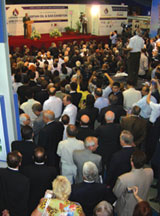  Left:
The oil projects in Azerbaijan have resulted in the annual
Caspian Oil and Gas Exhibition, which has been held in Baku every
year since 1994. Here, President Ilham Aliyev addresses the conference
guests at the opening ceremony at the 13th Annual Conference.
June 2006Woodward: Left:
The oil projects in Azerbaijan have resulted in the annual
Caspian Oil and Gas Exhibition, which has been held in Baku every
year since 1994. Here, President Ilham Aliyev addresses the conference
guests at the opening ceremony at the 13th Annual Conference.
June 2006Woodward:
Yes, and you have to keep it from rusting. Externally, we
do that through a coating and something called a cathodic protection
system. Internally, we add a chemical corrosion inhibitor to
the oil and send devices called "pigs" down the line
every few days to sweep water and debris out of the line that
might cause corrosion. We also ran "intelligence pigs"
down the line, shortly after construction and, will continue
to do so about every three years.
This apparatus can measure the
thickness of the pipe walls. So if there is any damage done through
corrosion, or perhaps inadvertently by a farmer, then this can
be detected by the "intelligence pig"
So oil flowing from a reservoir about 2-3 thousand meters below
the seabed of the Caspian passes up through one of our wells
and comes to one of our production platforms.
Then, water is separated from the oil, gas is separated, and
then partly processed, and the oil travels along the seabed flow
lines until it arrives at the Sangachal Terminal.There it is
further processed. Any residual water is removed and the oil
is heated to boil off the residual gases. From there it goes
into storage tanks, then into the pipeline to begin its long
journey to Ceyhan, Turkey, through these pump stations, up over
the mountains, under rivers and eventually to storage tanks at
the terminal at Ceyhan. Every day tankers turn up at the jetty
to fill up with oil and then it will sail off to terminals somewhere
in Europe or even the United States.
AI: And then it goes to refinery?
Woodward: And then it goes off to a refinery.
The refinery will extract the various products from it. Crude
oil is a mix of a whole range of hydrocarbons from light to heavy.
When you refine oil, you are really just distilling it and taking
various cuts.
Some of them will be at the heavy end-the bitumen or tar that
you put on the roads. Some of it will be fuel oil that is consumed
in power stations. Some
will be diesel, gasoline, or even liquefied petroleum gases -
like propane - that is used in camping gear.
It's a fascinating business.
I don't think we do a very good job of explaining to people what's
involved in finding and producing oil and gas around the world.
There's so much technology involved to develop these resources.
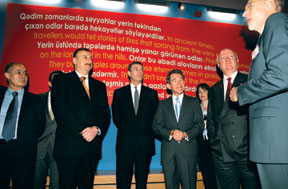  Left: Gathered at the Caspian Energy Centre at the Sangachal
Terminal to inaugurate
the completion of the Azerbaijan section of BTC pipeline on May
25, 2005. (From left): Turkish President Ahmet Necdet Sezer,
Azerbaijan's President Ilham Aliyev, Duke of York Prince Andrew
of the UK, BP's Chief Executive John Browne, U.S. Secretary of
Energy Spencer Abraham, and BP's David Woodward Left: Gathered at the Caspian Energy Centre at the Sangachal
Terminal to inaugurate
the completion of the Azerbaijan section of BTC pipeline on May
25, 2005. (From left): Turkish President Ahmet Necdet Sezer,
Azerbaijan's President Ilham Aliyev, Duke of York Prince Andrew
of the UK, BP's Chief Executive John Browne, U.S. Secretary of
Energy Spencer Abraham, and BP's David Woodward
Some of the oil and
gas fields now being found are in offshore waters 10 thousand
feet deep. That's a couple of miles down just to reach the seabed.
And then the field itself might be another 3, 4 or 5 miles down
below that.
Just think what's involved to be able to figure out where oil
and gas is located and then successfully develop it, transport
it to market, refine it and then deliver it every day-day in
and day out-into people's cars or homes and so on.
To me, it's a remarkable achievement which most people take for
granted or they consider it an irritation because they have to
pay $3 per gallon for petrol in the U.S., or $7 in the UK because
of tax, which is still less than the price of mineral water.
AI: When you see how complex
the entire process is, it's really amazing!
Woodward: Unfortunately, people tend to think
of the oil industry as low tech and that high tech industries
are in Silicon Valley [computer technology] or the pharmaceutical
industry. But you should see some of the technology that we use.
We probably use some of the biggest computers and most advanced
computer processing of any industry.
AI: For what kinds of things?
Woodward: Well, for example, seismic data processing.
Vast amounts of data, essentially sound echoes, from subsurface
formations are processed to study the formations under the ground
and identify where oil and gas is most likely to be found. Nowadays,
we can use seismic to determine how oil, water and gas are moving
in a producing reservoir and, hence, optimize the development
of the reservoir and maximize oil recovery.
The oil industry is often perceived as a dirty business that
pollutes and damages the environment. But again, if you consider
how much oil we develop and move around the world, very, very
little of it actually gets spilled into the environment. Every
now and then, there is an accident but we're normally pretty
good at dealing with it. Sometimes it's not the oil companies,
but shipping companies. Increasingly, oil companies like BP are
starting to take more control of the transportation of their
products around the world because we get a bad name if there
is a spill somewhere.
AI: Why did it take so long
to build the pipeline in Azerbaijan?
Woodward: Back in 1998, there were discussions
about the pipeline being up and running in 2001. I came here
at the end of 1998 and at that time, the oil price was $10 a
barrel [now it's $70 per barrel]. We didn't even have a development
plan for Azeri - Chirag - Gunashli (ACG) Full Field Development.
We had not selected the pipeline route. Some people were saying
Baku - Ceyhan [via Turkey] was the best choice. Others insisted
on Baku - Supsa [via Georgia, through the Black Sea down through
the Turkish Straits]. And some promoted Baku - Novorossiysk [via
Russia]
It was probably about the year
2000 before we eventually got agreement from a sufficient number
of partners to be able to pursue the Baku - Ceyhan route. And
that was conditional on our being able to negotiate reasonable
transit agreements with each of the countries - Azerbaijan, Georgia
and Turkey. It was also subject to our being able to engineer
the pipeline at an acceptable cost and to find companies willing
to commit sufficient oil to the pipeline and so on. You don't
build a pipeline of this scale on a speculative basis in hopes
that somebody might use it. You need to have sufficient companies
willing to commit to transport agreed quantities of oil via the
pipeline.
AI: So, actually, the process
of persuading people about all of these issues can take more
time than the actual construction of the infrastructure to develop
oil.
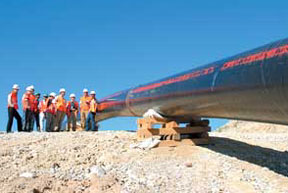  Left: A
team of ecologists examining the BTC pipeline in Southern Turkey.
The pipeline has been buried the entire length of the route and
the ground cover has been restored to its previous condition
before the constructionWoodward: Left: A
team of ecologists examining the BTC pipeline in Southern Turkey.
The pipeline has been buried the entire length of the route and
the ground cover has been restored to its previous condition
before the constructionWoodward:
Almost. The engineering
of the pipeline and, particularly, its construction is relatively
straightforward. That's not to minimize or diminish the many
challenges that were tackled by the construction teams and engineers.
But really the difficult part was in getting a sufficient number
of participants to agree that they were willing to fund it. They
had to be convinced that they would get an adequate return on
their investment.
A key part of this is concluding agreements with the transit
countries - Azerbaijan, Georgia, and Turkey. You must have confidence
that none of the transit countries will suddenly change the terms
once you've made your investment.
Almost two years were spent negotiating the various agreements
with the transit countries before we knew what the basis would
be for building this pipeline if it was going to be built. This
included the transit fees - in other words, the amount that these
countries would charge for each barrel of oil moving through
the pipeline in their country. What tax terms would apply? What
assurance would we have that once the pipeline was actually built,
that the terms would not get changed? Who would be responsible
for the security of the pipeline? And so on.
Once we got all of the agreements, we were able to focus more
on selecting the actual route of the pipeline, the engineering
of it and the cost estimates. In parallel with those decisions,
the partners agreed that they would seek external financing.
So we went to the World Bank and the European Bank for Reconstruction
and Development (EBRD) and then to a group of commercial banks
to borrow about 2.5 billion dollars towards the cost of the pipeline.
These banks had requirements regarding the social and environmental
impact of the pipeline. Tens of thousands of pages of documents
had to be submitted to the lenders to satisfy them that everything
was going to be done to the standards that they required. After
that, they would release the money.
So the construction of the pipeline did not get started until
late 2002. It has then taken us about three and a half years
to actually construct, commission and get it into operation.
AI: Which is really quite
fast. Yes?
Woodward: Yes, it is really quite fast when you
consider the scale of the pipeline and all of the technical challenges.
At the peak of the pipeline construction, we had 22,000 workers
working on it. Think about how many camps you must have along
the pipeline route to accommodate all these thousands of workers.
How many meals you have to serve daily. This is a huge operation
in its own right. And those people have to be driven out to the
work site everyday because each camp would have several hundred
or even a thousand workers but they operated over a line length
of 100 kilometers or more. We had to have buses to transport
them out to the work site, get lunches and drinks to them so
that they could function throughout the day, and then transfer
them back to the camps at night so they could get a night's rest.
One tends to overlook such things. The publicity around the pipeline
has, perhaps, had more emphasis on the political dimensions,
the environmental aspects and security. One tends to forget the
enormous logistics, the engineering, and the pure construction
activities - like river crossings. Consider how much effort is
involved in boring a hole the distance of a kilometer underneath
a river.
For example, the width of the Kur River and its flood plain at
the location of the horizontal directional drill crossing (HDD)
in eastern Georgia is approximately one kilometer. The river
itself is about 100 meters wide however the HDD needed to traverse
under the entire flood plain.
AI: And some of those rivers
are deep and quite swift.
Woodward: Oh yes, which is why you have to start
well back from either side of the river banks and bore down at
an angle to a depth of perhaps 10-15 meters below the deepest
part of the river.
AI: How did you finally decide
on the Baku-Ceyhan route?
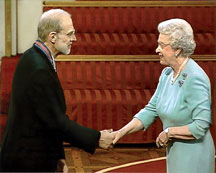  Left: Queen
Elizabeth II congratulating David Woodward after bestowing upon
him the Order of St. Michael and St. George for the tremendous
role he has played in the development of the oil industry in
Azerbaijan for the past eight yearsWoodward: Left: Queen
Elizabeth II congratulating David Woodward after bestowing upon
him the Order of St. Michael and St. George for the tremendous
role he has played in the development of the oil industry in
Azerbaijan for the past eight yearsWoodward:
Ultimately, as far as
we were concerned, it was very clear that the country that had
the resources - Azerbaijan - desired to export its oil to international
markets by a pipeline that went through Turkey and that gave
direct access to the Mediterranean and the world market. Although
we and our partners originally looked at several alternatives;
ultimately, the deciding factor was our desire to align ourselves
with the host country.
Although there was an argument that there were routes that would
have cost less than Baku-Ceyhan; for example, Supsa or Novorossiysk,
there would have required the necessity to go through the Turkish
Straits, which are environmentally sensitive and becoming increasingly
congested with tanker traffic. Taking into account the need to
bypass the Turkish Straits, BTC is a commercially competitive
solution.
AI: What can you tell us about the security of this operation?
Woodward: Security, clearly, was one of the important
criteria for deciding the route of the pipeline, and its design.
We've had a lot of advice from the authorities here in Azerbaijan
and from Western governments. As the pipeline is buried, it's
not that easy to find. The pump stations and facilities that
are above ground have protection along with access control, security
systems and cameras.
We have pipeline patrols along the entire route. Generally, these
patrols riding horseback that are hired from local communities
and who personally know the farmers and shepherds and people
from these areas. So, if someone is inadvertently attempting
to carry out activities too close to the pipeline, the patrols
will remind them to be careful and, of course, they can keep
an eye out for others who might not be as well - intentioned.
We've developed and will continue to maintain good relations
with communities along the pipeline route. We've spent quite
a lot of money on schools, clinics, minor infrastructure. We've
provided micro - financing to assist the development of local
enterprises. We're trying to help these communities build the
capacity to help themselves.
AI: How many communities
are there that are located along the pipeline route?
Woodward: There are several hundred that are in
the "corridor" on either side of the pipeline. We have
community liaison officers who are in contact with the communities
on a regular basis in case they have any issues or concerns about
our activities, so the community can raise them and have them
dealt with. It's very important for us to maintain good relationships
with the people in the proximity of the facilities.
  Left: David
Woodward with his family at Buckingham Palace in London after
being invested with the Order of St. Michael and St. George by
her Majesty Queen Elizabeth II. Left to right: Wife Quinta, David
Woodward, son Mark and daughter Selina. March 29, 2006 Left: David
Woodward with his family at Buckingham Palace in London after
being invested with the Order of St. Michael and St. George by
her Majesty Queen Elizabeth II. Left to right: Wife Quinta, David
Woodward, son Mark and daughter Selina. March 29, 2006
Beyond that, the government
in each of the countries has the responsibility for ensuring
the security of the pipeline and they have recruited and trained
forces to undertake this task. So there are multiple layers of
security in place.
To change the subject, let's talk about you. Isn't it quite
unusual in BP for one manager to be in the same position for
eight years? Isn't that quite rare?
Yes, it is unusual. And it's
the longest period of time that I've had the same assignment
in my career. These large-scale projects take quite a long time.
As people build familiarity and relationships, there's value
in being able to maintain that continuity.
AI: This is such a huge project. How do you find yourself
different after eight years?
It's worked out for me and my
family that we've been happy to stay here and see these projects
through to completion. I've derived an enormous amount of satisfaction
in being involved in something from the early conceptual phases
all the way through to operation.
As you accumulate experience,
I think you're less likely to view something as a real crisis.
I've seen a fair number of crises over the years and I've had
my share of worries and concerns. Perhaps, I'm less likely now
to panic when problems occur, as inevitably they will. I'm confident
that we can work our way through all the difficulties somehow.
AI: Well, what's next?
Woodward: For BP and the project, this is just
the beginning. We've built these facilities in order to produce
the oil and to export it for decades to come.
And, of course, there's gas, we've got the Shah Deniz Stage 1
project underway. Within the next few months, we'll start up
gas production, which will flow along a pipeline parallel to
the BTC pipeline. It's a separate pipeline but it follows the
same route. Shah Deniz will produce gas, not in liquid form,
but like the air around us. We'll compress it a bit so we can
get more of it down the pipeline.
There will be further stages of development of both ACG and Shah
Deniz as we build the production up to the maximum capacity of
the pipeline. Then there's the potential to expand the pipeline.
An inter-governmental agreement between Azerbaijan and Kazakhstan
was signed in June 2006 and at some stage in the future, Kazakh
oil will almost certainly flow through BTC.
AI: There's no pipeline under
the Caspian right now, so does that mean oil will cross by tanker?
Woodward: Initially, transport will take place
by tanker and then, depending upon the volumes of oil, they may
decide to lay a pipeline on the bottom of the Caspian. More oil
coming from Kazakhstan may well require the expansion of BTC
pipeline. There are various ways by which we can increase its
throughput; for example, some additional pump stations and pumps
might be added to the line. Finally, oil is heading to market
but that's really just the start of things.
AI: And yourself? What are
your plans? Are you staying on?
Woodward: I expect to
move on towards the end of this year. It will be eight years
that I've been here in Azerbaijan. So, it's time for something
different and for somebody else to come to lead the business
here. I'll be retiring from BP and moving on to a new phase in
my life.
[Note: Bill Schrader has since been named as the new President
for BP Azerbaijan who will head the AIOC project starting in
November. See Faces / Places in this issue.]
We've had a marvelous time here but it's been hugely demanding
on my family and one tends to neglect so many other aspects of
life. There are other things in life that I'd like to devote
more time to.
One gets a lot of satisfaction in being associated with something
that is as big and challenging as our projects in Azerbaijan,
but I think the greatest satisfaction has come from the way in
which we have approached each task. We have devoted enormous
care to the environment, to the social impact that the pipeline
has upon communities, to the way that we have looked after the
safety of our workers, maintaining high ethical standards and
by being very transparent about everything that we've done. We've
gone beyond what you might expect a company to do when undertaking
projects of this scale. It's the process - the way we've gone
about it - and the concern we've tried to show for people that
means so much to me.
Of course, there has been some criticism from NGOs [non-governmental
organizations], and the media, But I've always felt that we could
stand up to such scrutiny and challenge because we were confident
that we were doing our job to the highest standard. If valid
concerns were raised then we endeavored to engage with those
concerned to see if we could address their issues and improve
the project still further. I've always felt an enormous genuine
pride in what we have accomplished here in Azerbaijan.
______
Back to Index AI 14.3
(Autumn 2006)
AI Home | Search | Magazine
Choice
| Topics
| AI Store | Contact us
Other Web sites
created by Azerbaijan International
AZgallery.org | AZERI.org | HAJIBEYOV.com
|





